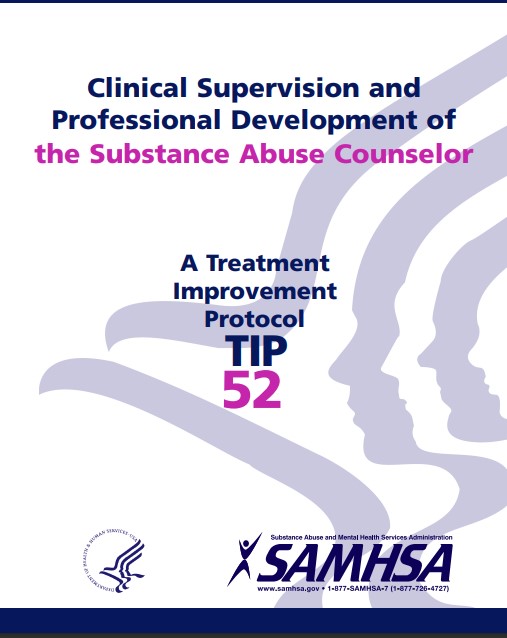Clinical Supervision and Professional Development of the Substance Abuse Counselor

Clinical Supervision and Professional Development of the Substance Abuse Counselor
Treatment Improvement Protocol (TIP) Series 52
Clinical Supervision and Professional Development of the Substance Abuse Counselor – What Is a TIP? Treatment Improvement Protocols (TIPs) are developed by the Center for Substance Abuse Treatment (CSAT), part of the Substance Abuse and Mental Health Services Administration (SAMHSA) within the U.S. Department of Health and Human Services (HHS).
Each TIP involves the development of topic specific best practice guidelines for the prevention and treatment of substance use and mental disorders. TIPs draw on the experience and knowledge of clinical, research, and administrative experts of various forms of treatment and prevention.
TIPs are distributed to facilities and individuals across the country. Published TIPs can be accessed via the Internet at http://store.samhsa.gov.
Although each consensus-based TIP strives to include an evidence base for the practices it recommends, SAMHSA recognizes that behavioral health is continually evolving, and research frequently lags behind the innovation’s pioneered in the field.
A major goal of each TIP is to convey “frontline” information quickly but responsibly. If research supports a particular approach, citations are provided.
How This TIP Is Organized
This TIP is divided into three parts:
• Clinical Supervision and Professional Development of the Substance Abuse Counselor, Part 1.
• Clinical Supervision and Professional Development of the Substance Abuse Counselor: An Implementation
Guide for Administrators, Part 2.
• Clinical Supervision and Professional Development of the Substance Abuse Counselor: A Review of the
Literature, Part 3
Parts 1 and 2 are presented in this publication; Part 3 is available only online at http://store.samhsa.gov.
Part 1 of the TIP is for clinical supervisors and consists of two chapters. Chapter 1 presents basic information about clinical supervision in the substance abuse treatment field. It covers:
• Central principles of clinical supervision and guidelines for new supervisors, including the functions of a clinical supervisor.
• The developmental levels of counselors and clinical supervisors.
• Information on cultural competence, ethical and legal issues such as direct and vicarious liability, dual relationships and boundary issues, informed consent, confidentiality, and supervisor ethics.
• Information about monitoring clinical performance of counselors, the various methods commonly used for observing counselors, the methods and techniques of supervision and administrative supervision, and practical issues such as balancing one’s clinical and administrative duties, finding the time to do clinical supervision, documentation, and structuring clinical supervision sessions.
Chapter 2 presents the “how to” of clinical supervision. Chapter 2 contains:
• Representative vignettes of clinical supervision scenarios.
• Master supervisor notes and comments that help you understand the thinking behind the supervisor’s approach in each vignette.
• “How to” descriptions of specific techniques.
It is strongly recommended that you read chapter 1 before reading chapter 2.
Part 2 is an implementation guide for program administrators and consists of two chapters. Chapter 1 lays out the rationale for the approach taken in chapter 2 and will help administrators understand the benefits and rationale behind providing clinical supervision for their program’s substance abuse counselors.
Chapter 2 provides tools for making the tasks associated with implementing a clinical supervision system easier.
The following topics are addressed in Part 2:
• How to develop a model for clinical supervision and implement a clinical supervision program.
• Key issues for administrators to consider, including assessing organizational structure and readiness.
• Legal and ethical issues to consider.
• Cultural competence issues.
• Providing professional development for clinical supervisors.
Part 3 of this TIP is a literature review on the topic of clinical supervision and is available for use by clinical supervisors, interested counselors, and administrators. Part 3 consists of three sections: an analysis of the available literature, an annotated bibliography of the literature most central to the topic, and a bibliography of other available literature. It includes literature that addresses both clinical and administrative concerns.
To facilitate ongoing updates (which will be performed every 6 months for up to 5 years from first publication), the literature review will be available only online at http://store.samhsa.gov.
Chapter 1
Clinical supervision is emerging as the crucible in which counselors acquire knowledge and skills for the substance abuse treatment profession, providing a bridge between the classroom and the clinic.
Supervision is necessary in the substance abuse treatment field to improve client care, develop the professionalism of clinical personnel, and impart and maintain ethical standards in the field.
In recent years, especially in the substance abuse field, clinical supervision has become the cornerstone of quality improvement and assurance.
Your role and skill set as a clinical supervisor are distinct from those of counselor and administrator. Quality clinical supervision is founded on a positive supervisor–supervisee relationship that promotes client welfare and the professional development of the supervisee.
You are a teacher, coach, consultant, mentor, evaluator, and administrator; you provide support, encouragement, and education to staff while addressing an array of psychological, interpersonal, physical, and spiritual issues of clients.
Ultimately, effective clinical supervision ensures that clients are competently served. Supervision ensures that counselors continue to increase their skills, which in turn increases treatment effectiveness, client retention, and staff satisfaction. The clinical supervisor also serves as liaison between administrative and clinical staff.
This TIP focuses primarily on the teaching, coaching, consulting, and mentoring functions of clinical supervisors. Supervision, like substance abuse counseling, is a profession in its own right, with its own theories, practices, and standards. The profession requires knowledgeable, competent, and skillful individuals who are appropriately credentialed both as counselors and supervisors.
Definitions
This document builds on and makes frequent reference to CSAT’s Technical Assistance Publication (TAP), Competencies for Substance Abuse Treatment Clinical Supervisors (TAP 21A; CSAT, 2007).
The clinical supervision competencies identify those responsibilities and activities that define the work of the clinical supervisor. This TIP provides guidelines and tools for the effective delivery of clinical supervision in substance abuse treatment settings. TAP 21A is a companion volume to TAP 21, Addiction Counseling Competencies (CSAT, 2006), which is another useful tool in supervision.
“The perspective of this TIP is informed by the following definitions of supervision.”
• “Supervision is a disciplined, tutorial process wherein principles are transformed into practical skills, with four overlapping foci: administrative, evaluative, clinical, and supportive” (Powell & Brodsky, 2004, p. 11). “Supervision is an intervention provided by a senior member of a profession to a more junior member or members. . . . This relationship is evaluative, extends over time, and has the simultaneous purposes of enhancing the professional functioning of the more junior person(s); monitoring the quality of professional services offered to the clients that she, he, or they see; and serving as a gatekeeper of those who are to enter the particular profession” (Bernard & Goodyear, 2004, p. 8).
• Supervision is “a social influence process that occurs over time, in which the supervisor participates with supervisees to ensure quality of clinical care. Effective supervisors observe, mentor, coach, evaluate, inspire, and create an atmosphere that promotes self-motivation, learning, and professional development. They build teams, create cohesion, resolve conflict, and shape agency culture, while attending to ethical and diversity issues in all aspects of the process.
Such supervision is key to both quality improvement and the successful implementation of consensus and evidence-based practices” (CSAT, 2007, p. 3).
READ MUCH MORE INSIDE…163 Pages
“CLINICAL SUPERVISION AND PROFESSIONAL DEVELOPMENT OF THE SUBSTANCE ABUSE COUNSELOR” $32.60
Our 100% Money Back Guarantee:

If for any reason you decided within 30 days that “CLINICAL SUPERVISION AND PROFESSIONAL DEVELOPMENT OF THE SUBSTANCE ABUSE COUNSELOR” isn’t for you, simply notify us by email and we’ll gladly refund your money – no questions asked. That’s our Ironclad Guarantee!
The risk is entirely ours! You absolutely have nothing to lose!
Warmest Regards, Coyalita
Behavioral Health Rehabilitative Specialist & Addiction Counselor
Copyright © 2021-2024 Thresholdlivecoyalita.com All Rights Reserved Privacy Policy – Earnings Disclaimer – Terms of Use – Contact Us





